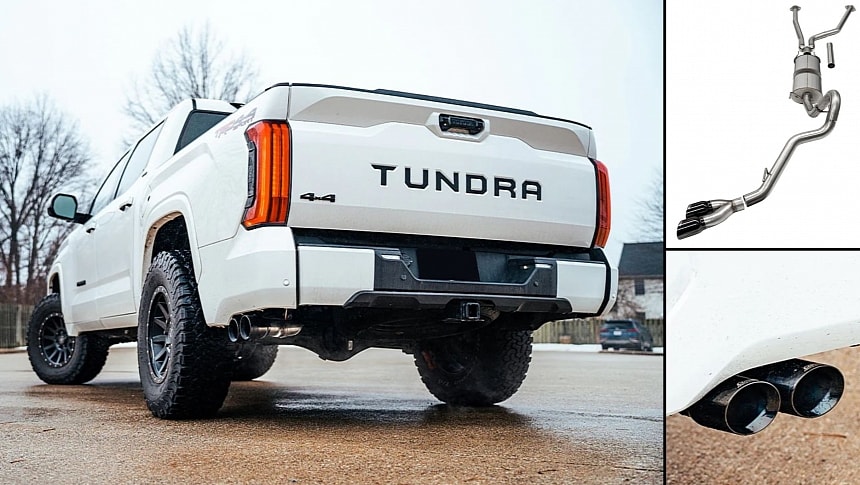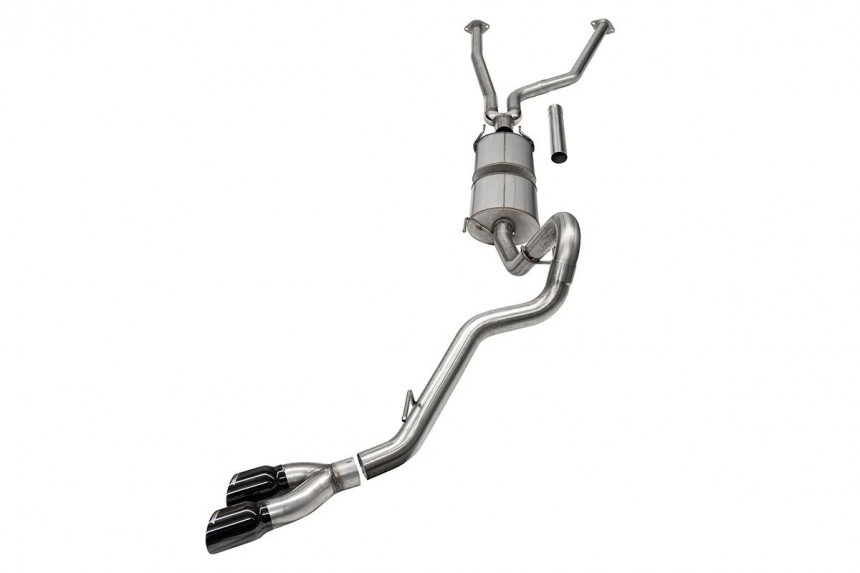In production since December 2021 for the 2022 model year, the third-generation Tundra is completely different from its predecessor, beginning with the TNGA-F platform. Under the hood, the biggest change is the switch from a free-breathing V8 to a twin-turbocharged V6 engine.
Described by some as being a 3.5 due to its codename, the V35A-FTS actually displaces 3.4 liters. Although it sounds perfectly fine completely stock, the force-fed sixer is hardly special. The folks at Corsa Performance can upgrade the aural experience with a cat-back exhaust system that fits both wheelbases and cab options of the Tundra.
Corsa's new exhaust comprises 304 stainless steel for the 3.0-inch piping, dual outlets on the driver side of the rear bumper, 4.0-inch tips, and two finishes. Polished tips will set you back $1,574 for the entire system, whereas black tips are priced at $1,624 on the Ohio-based company's website.
The attached videos should give prospective customers a good idea in regard to the spicier exhaust note at start-up and under acceleration. Benefitting from no-drone technology and a lifetime warranty, the Corsa Performance cat-back exhaust is also compatible with the hybrid setup.
Said exhaust promises a 16.5% increase in flow and weight savings of three pounds (make that 1.4 kilograms in the metric system). Unfortunately, Corsa Performance didn't bother to publish a dyno graph of the Tundra with the cat-back exhaust.
Cat-back exhaust refers to pretty much everything after the catalytic converter, therefore resulting in minimal power and torque gains over the stock exhaust system. Had it also included performance catalytic converters and less restrictive downpipes, chances are that Corsa Performance would have published a dynamometer graph on its website.
In stock form, the V35A-FTS is rated at either 348 or 389 horsepower. Torque ranges between 405 pound-feet (550 Nm) at 2,000 revolutions per minute for the SR and 479 pound-feet (650 Nm) at 2,400 revolutions per minute for the SR5 and higher trim levels. The i-FORCE MAX hybrid is good for 437 horsepower and 583 pound-feet (790 Nm), which makes it punchier than Ford's PowerBoost.
Available powertrain choices are joined by a ten-speed automatic supplied by Toyota subsidiary Aisin. The AWR10L transmission is also shared with the Land Cruiser 300 series, technically similar Lexus LX, the GX 550, and the LS flagship sedan.
The most you can expect to squeeze out of the Gen 3 Tundra is 22 miles per gallon (10.7 liters per 100 kilometers) in the case of the 4x2 i-FORCE MAX or 20 (11.8) with four-wheel drive. Without hybrid assistance, the EPA's fuel economy estimates drop to 20 and 19 miles per gallon (11.8 and 12.4 liters per 100 kilometers). Toyota delivered 125,185 units of the Tundra in the US last year. Care to guess how many of them were hybrids? The answer is 30,303 pickup trucks, meaning 30.3% of the grand total.
Corsa's new exhaust comprises 304 stainless steel for the 3.0-inch piping, dual outlets on the driver side of the rear bumper, 4.0-inch tips, and two finishes. Polished tips will set you back $1,574 for the entire system, whereas black tips are priced at $1,624 on the Ohio-based company's website.
The attached videos should give prospective customers a good idea in regard to the spicier exhaust note at start-up and under acceleration. Benefitting from no-drone technology and a lifetime warranty, the Corsa Performance cat-back exhaust is also compatible with the hybrid setup.
Said exhaust promises a 16.5% increase in flow and weight savings of three pounds (make that 1.4 kilograms in the metric system). Unfortunately, Corsa Performance didn't bother to publish a dyno graph of the Tundra with the cat-back exhaust.
In stock form, the V35A-FTS is rated at either 348 or 389 horsepower. Torque ranges between 405 pound-feet (550 Nm) at 2,000 revolutions per minute for the SR and 479 pound-feet (650 Nm) at 2,400 revolutions per minute for the SR5 and higher trim levels. The i-FORCE MAX hybrid is good for 437 horsepower and 583 pound-feet (790 Nm), which makes it punchier than Ford's PowerBoost.
Available powertrain choices are joined by a ten-speed automatic supplied by Toyota subsidiary Aisin. The AWR10L transmission is also shared with the Land Cruiser 300 series, technically similar Lexus LX, the GX 550, and the LS flagship sedan.
The most you can expect to squeeze out of the Gen 3 Tundra is 22 miles per gallon (10.7 liters per 100 kilometers) in the case of the 4x2 i-FORCE MAX or 20 (11.8) with four-wheel drive. Without hybrid assistance, the EPA's fuel economy estimates drop to 20 and 19 miles per gallon (11.8 and 12.4 liters per 100 kilometers). Toyota delivered 125,185 units of the Tundra in the US last year. Care to guess how many of them were hybrids? The answer is 30,303 pickup trucks, meaning 30.3% of the grand total.










